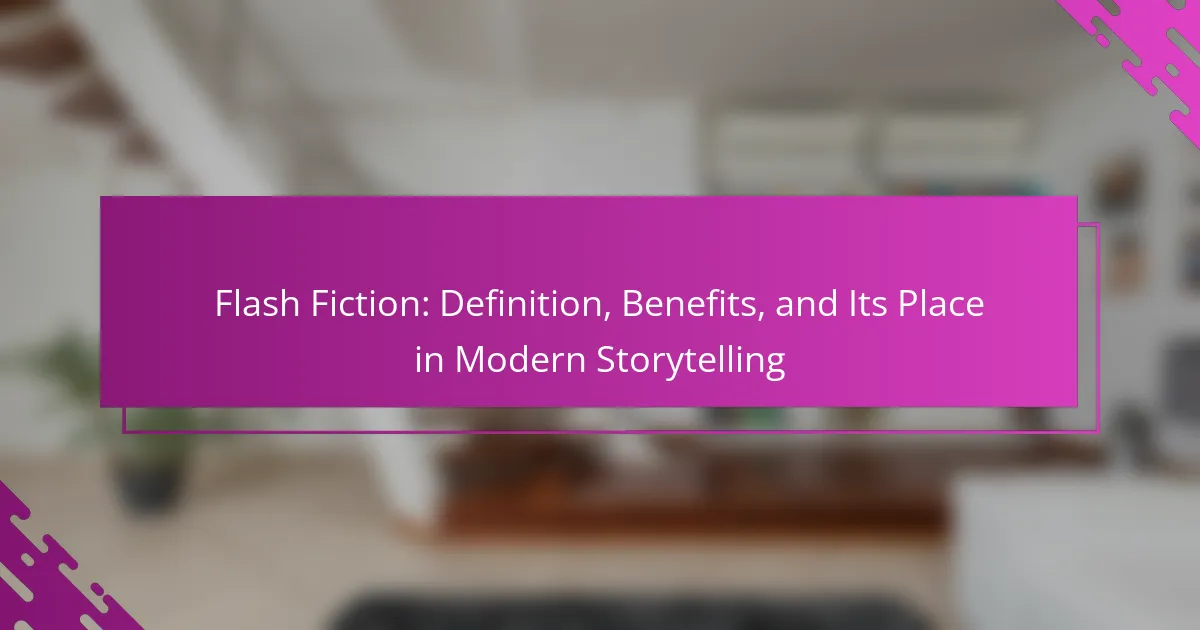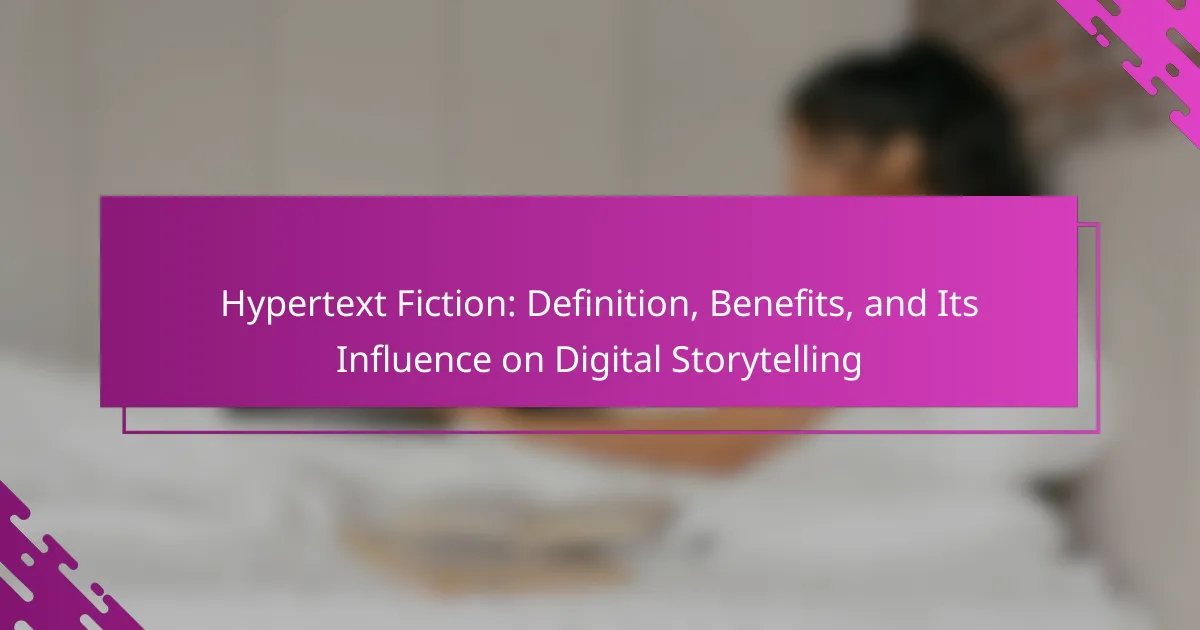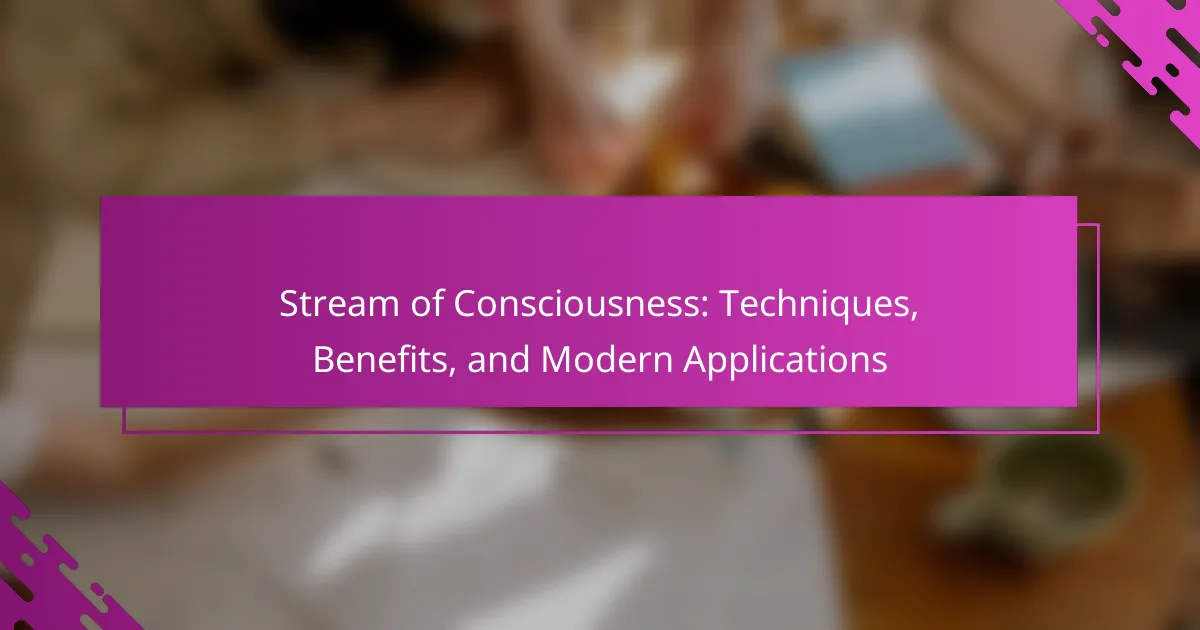Postmodernism reshapes our understanding of narrative through its skepticism and irony. Key features include fragmentation, intertextuality, and self-referentiality. Influential works like “Gravity’s Rainbow” and “Infinite Jest” exemplify these traits, challenging traditional storytelling. The impact of postmodernism extends across cultures, reflecting diverse perspectives and contemporary societal issues.
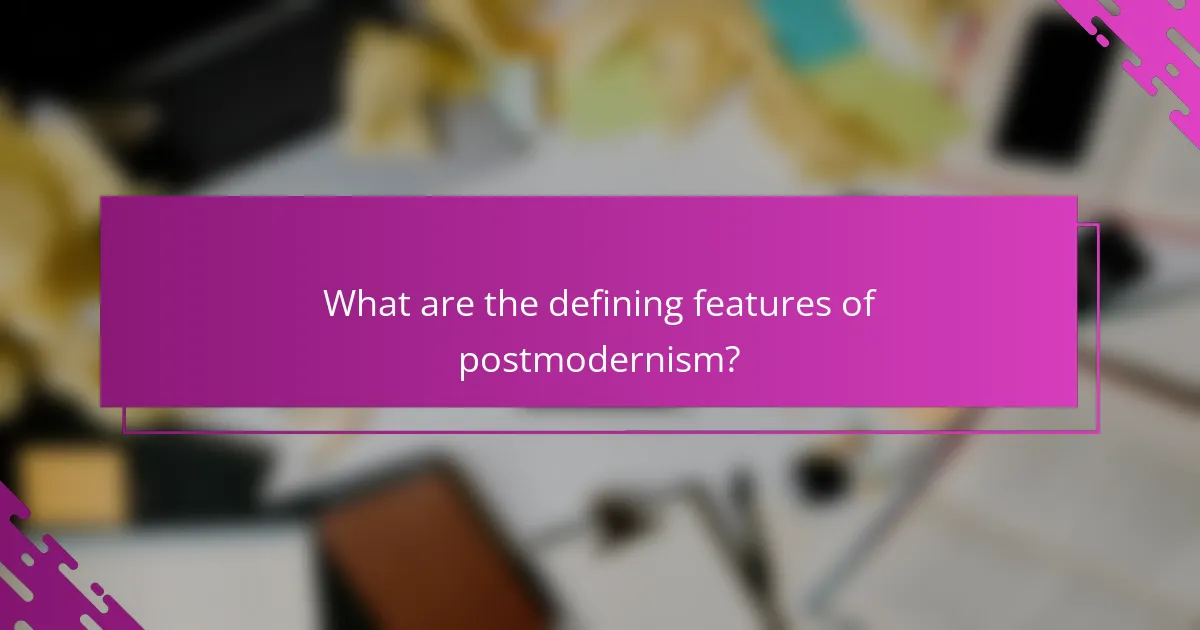
What are the defining features of postmodernism?
Postmodernism is characterized by skepticism, irony, and a questioning of grand narratives. Key features include fragmentation, intertextuality, and self-referentiality. These elements challenge traditional narrative structures and promote diverse perspectives. Postmodern works often blur the lines between high and low culture, emphasizing the role of the audience in meaning-making.
How does postmodernism differ from modernism?
Postmodernism differs from modernism primarily in its skepticism of grand narratives and objective truths. Postmodernism embraces fragmentation, irony, and self-referentiality, contrasting with modernism’s focus on coherence and progress. Key works of postmodernism, such as Thomas Pynchon’s “Gravity’s Rainbow” and Don DeLillo’s “White Noise,” showcase these characteristics. The impact on narrative structure includes nonlinear storytelling and unreliable narrators, reflecting a departure from traditional forms.
What role does irony play in postmodern literature?
Irony plays a crucial role in postmodern literature by subverting traditional narratives and expectations. It often highlights contradictions and challenges established norms. This technique allows authors to create a sense of ambiguity and complexity, prompting readers to question reality and truth. Through irony, postmodern works can critique society while simultaneously engaging the reader in a deeper exploration of meaning. Notable examples include works by Thomas Pynchon and Don DeLillo, where irony enhances thematic depth and narrative structure.
Which narrative techniques are characteristic of postmodernism?
Postmodernism employs narrative techniques such as metafiction, nonlinear timelines, and unreliable narrators. These elements challenge traditional storytelling and emphasize the subjective nature of reality. Metafiction blurs the line between fiction and reality, while nonlinear timelines disrupt chronological order, creating complexity. Unreliable narrators introduce doubt, forcing readers to question the narrative’s truth. These techniques reflect postmodernism’s core attribute of questioning authority and embracing ambiguity.
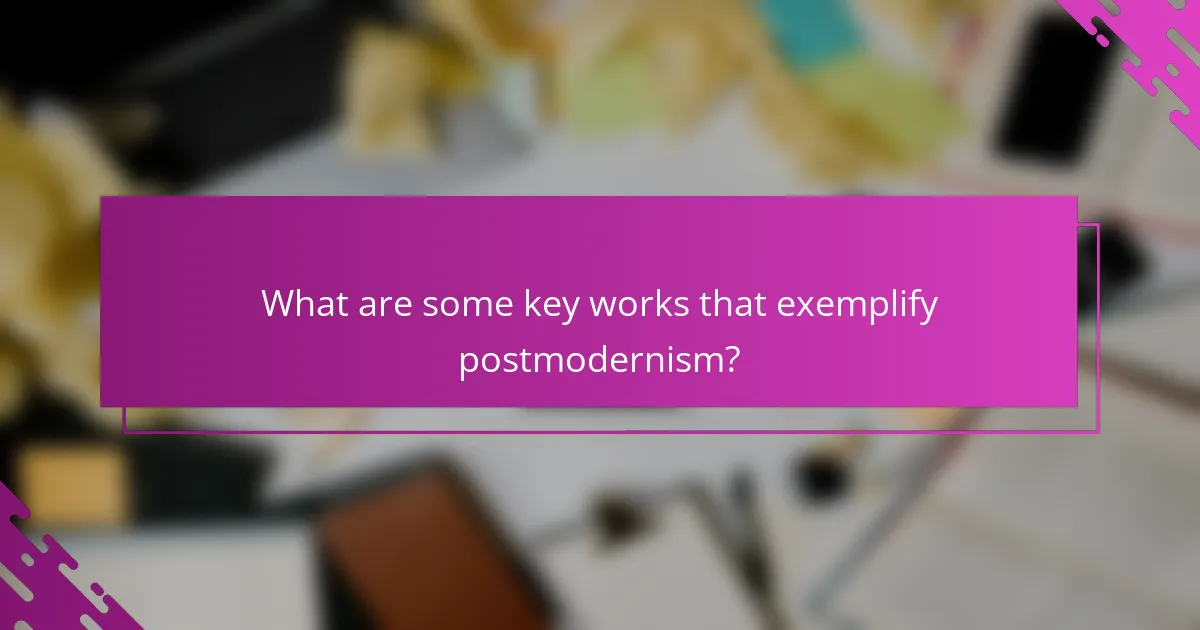
What are some key works that exemplify postmodernism?
Key works that exemplify postmodernism include “Gravity’s Rainbow” by Thomas Pynchon, “Infinite Jest” by David Foster Wallace, “White Noise” by Don DeLillo, and “The Crying of Lot 49” also by Pynchon. These texts showcase fragmented narratives, intertextuality, and metafictional elements, defining features of postmodern literature. Each work challenges traditional narrative structures, reflecting the complexities of contemporary life.
How does “Infinite Jest” reflect postmodern themes?
“Infinite Jest” exemplifies postmodern themes through its fragmented narrative and intertextuality. The novel presents a non-linear structure, reflecting the complexity of contemporary life. It challenges traditional storytelling by blending high and low culture, showcasing absurdity and irony. Characters grapple with addiction and entertainment, highlighting the disconnection in postmodern society. The work’s metafictional elements invite readers to question reality and narrative authority, reinforcing the postmodern condition.
What is the significance of “The Crying of Lot 49” in postmodern literature?
“The Crying of Lot 49” is significant in postmodern literature for its exploration of communication and meaning. The novel illustrates the fragmentation of reality and the complexity of interpretation. Through its non-linear narrative and unreliable characters, it challenges traditional storytelling. The work embodies key postmodern themes like paranoia, hyperreality, and intertextuality. These elements highlight the difficulties of finding coherence in a chaotic world, making it a pivotal example of postmodern narrative structure.
Which authors are considered pivotal in the postmodern movement?
Key authors in the postmodern movement include Thomas Pynchon, Don DeLillo, and David Foster Wallace. Their works explore fragmented narratives and challenge traditional storytelling. Pynchon’s “Gravity’s Rainbow” exemplifies complex structures, while DeLillo’s “White Noise” critiques consumer culture. Wallace’s “Infinite Jest” merges humor with deep philosophical inquiries, showcasing postmodernism’s diverse impact on narrative structure.
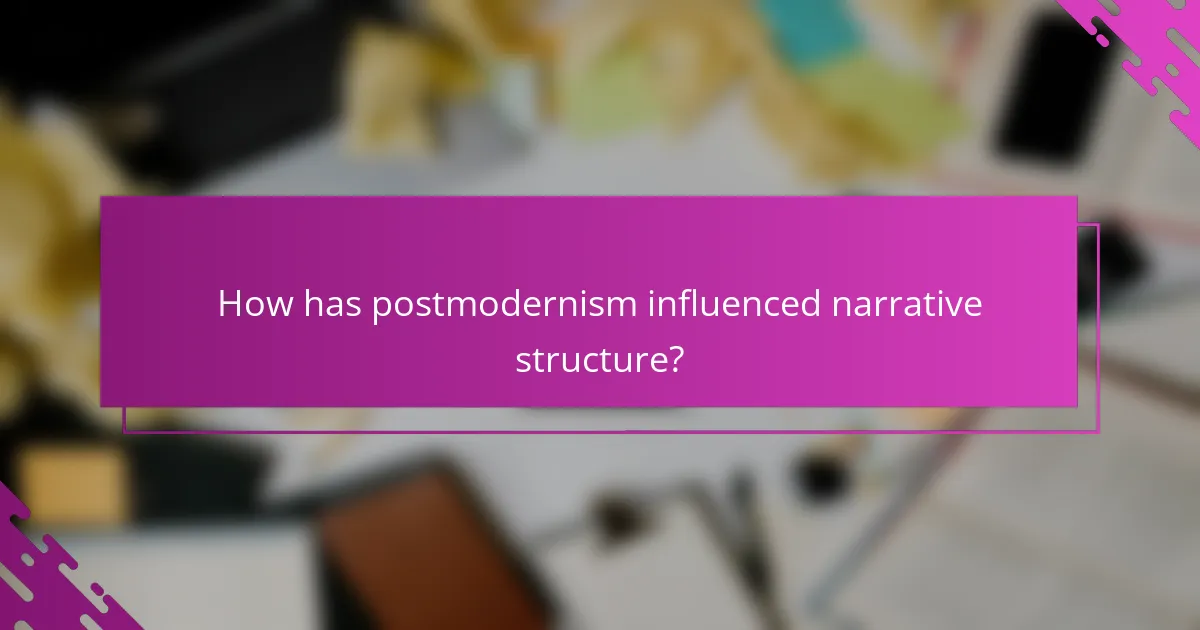
How has postmodernism influenced narrative structure?
Postmodernism has significantly influenced narrative structure by introducing non-linear storytelling, fragmented plots, and unreliable narrators. These elements challenge traditional narrative forms and encourage reader interpretation. Key works like “Slaughterhouse-Five” by Kurt Vonnegut exemplify this shift, blending time and perspective. As a result, narratives often reflect complexity and ambiguity, mirroring postmodernist themes.
What are the implications of fragmented narratives in postmodern works?
Fragmented narratives in postmodern works challenge traditional storytelling, creating multiple interpretations and emphasizing subjective experience. This structure reflects the complexity of reality, as seen in key texts like “Gravity’s Rainbow” and “Infinite Jest.” Such narratives invite readers to engage actively, crafting meaning from disjointed elements. As a result, they highlight the fluidity of truth and the instability of identity within contemporary culture.
How does metafiction challenge traditional storytelling?
Metafiction challenges traditional storytelling by self-referentially questioning narrative conventions. It disrupts reader expectations through techniques like breaking the fourth wall and exploring the nature of fiction itself. This approach emphasizes the constructedness of narratives, prompting readers to reflect critically on the storytelling process. Key works, such as “If on a winter’s night a traveler” by Italo Calvino, exemplify how metafiction can redefine character roles and plot structures, leading to a more interactive and engaging reading experience. As a result, metafiction alters the relationship between author, text, and audience, making the act of reading a participatory event.
In what ways does postmodernism address the concept of authorship?
Postmodernism challenges traditional authorship by promoting the idea that texts are collaborative and meaning is subjective. It blurs the line between author and reader, emphasizing that interpretation shapes narratives. This shift is evident in key works like “If on a winter’s night a traveler” by Italo Calvino, which illustrates fragmented storytelling. Additionally, postmodernism often employs pastiche and intertextuality, further complicating the notion of a singular authorial voice.
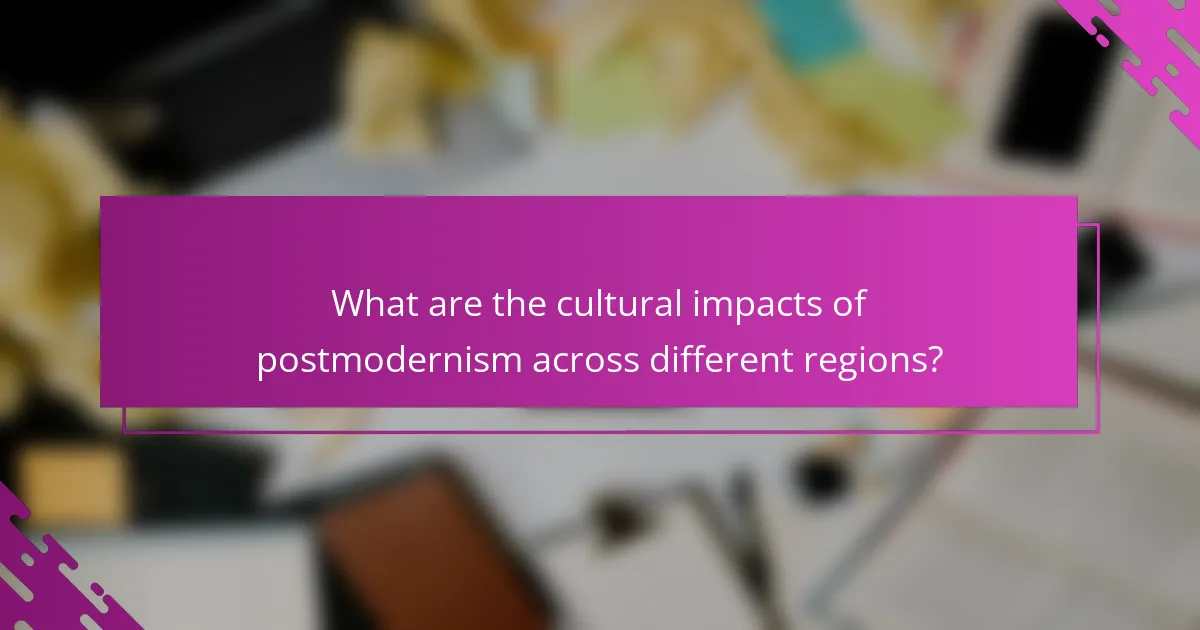
What are the cultural impacts of postmodernism across different regions?
Postmodernism significantly influences culture by challenging traditional narratives and embracing diversity. Its impact varies by region, reflecting local contexts and histories.
In North America, postmodernism promotes pluralism and deconstruction in literature and art. Works by authors like Thomas Pynchon and Don DeLillo illustrate fragmented storytelling, reshaping narrative structures.
In Europe, postmodernism critiques modernism and explores identity. The works of writers such as Salman Rushdie and Umberto Eco highlight cultural hybridity and intertextuality, fostering a dialogue between past and present.
In Asia, postmodernism often intersects with local traditions. Artists and writers blend contemporary themes with cultural heritage, as seen in the works of Haruki Murakami, who infuses magical realism with Japanese folklore.
Overall, postmodernism’s cultural impacts reflect a shift towards inclusivity and complexity, reshaping narratives across diverse regions.
How is postmodernism perceived in contemporary literature?
Postmodernism is perceived in contemporary literature as a complex interplay of irony, fragmentation, and intertextuality. It challenges traditional narrative structures, often blurring the line between fiction and reality. Key works, such as Thomas Pynchon’s “Gravity’s Rainbow” and Don DeLillo’s “White Noise,” exemplify this by employing non-linear storytelling and metafiction. As a result, readers encounter diverse perspectives and a multiplicity of meanings, reflecting the chaotic nature of modern life. This impact reshapes how narratives are constructed, encouraging experimentation and pushing boundaries in literary forms.
What are the responses to postmodernism in visual arts?
Responses to postmodernism in visual arts include a diverse range of styles and critiques. Artists often embrace fragmentation, irony, and pastiche, challenging traditional narratives. Key movements such as appropriation art and installation art exemplify these responses. Notable works, like Cindy Sherman’s photography and Jeff Koons’ sculptures, highlight the questioning of authorship and authenticity. These artistic expressions reflect the complexities of contemporary culture, emphasizing the subjective experience of reality.
Which cultural critiques have emerged from postmodern thought?
Postmodern thought has prompted critiques of cultural norms, questioning authority and challenging traditional narratives. It highlights the fragmentation of identity and meaning, emphasizing relativity in truth and values. Key critiques include the deconstruction of grand narratives, the questioning of objectivity, and the exploration of hyperreality. These critiques influence various fields, including literature, art, and philosophy, reshaping how culture is perceived and interpreted.
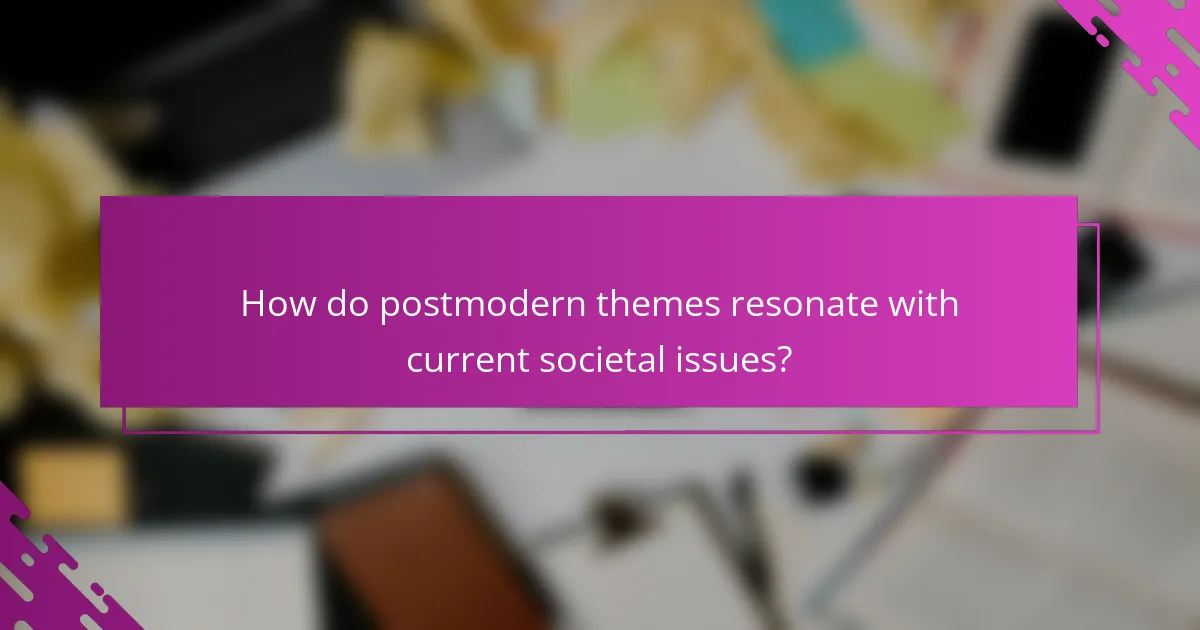
How do postmodern themes resonate with current societal issues?
Postmodern themes resonate with current societal issues by challenging traditional narratives and embracing complexity. This reflects the fragmented nature of contemporary life, where multiple perspectives coexist. Issues like identity, globalization, and technology are explored through irony and pastiche, mirroring society’s diverse experiences. For example, the emphasis on deconstruction highlights the instability of meaning, resonating with today’s discourse on truth and representation.
What reflections of identity can be found in postmodern narratives?
Postmodern narratives reflect identity through fragmented storytelling, unreliable narrators, and intertextuality. These features challenge traditional notions of self and reality. Characters often embody multiple identities, showcasing the complexity of human experience. Key works like “Beloved” by Toni Morrison and “Gravity’s Rainbow” by Thomas Pynchon exemplify this exploration. As a result, postmodernism invites readers to question the authenticity of identity in a multifaceted world.
How does postmodernism engage with technology and media?
Postmodernism engages with technology and media by emphasizing fragmentation, intertextuality, and hyperreality. It critiques traditional narratives, showcasing how media shapes perceptions of reality. Notable works include Jean Baudrillard’s “Simulacra and Simulation,” which explores the blurred lines between reality and representation. This engagement reflects a unique attribute of postmodernism, as it adapts to and critiques the rapid advancements in communication technologies.
What lessons can be learned from postmodernism in today’s context?
Postmodernism teaches lessons about the fluidity of truth and the importance of diverse perspectives. It encourages critical thinking and challenges traditional narratives, emphasizing that meaning is constructed rather than inherent. This approach fosters inclusivity and creativity in contemporary discourse, making it relevant today.
What best practices should writers consider when incorporating postmodern elements?
Writers should focus on intertextuality, metafiction, and fragmentation when incorporating postmodern elements. These techniques enhance narrative complexity and challenge traditional storytelling. Emphasizing unreliable narrators and non-linear timelines can deepen reader engagement. Incorporating pastiche allows for creative blending of genres, while self-referential commentary encourages critical thinking about narrative forms.
